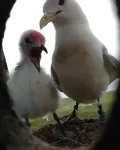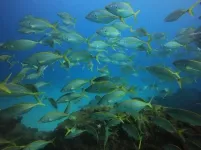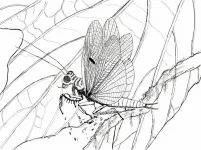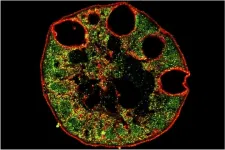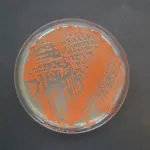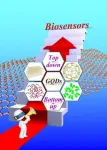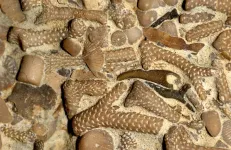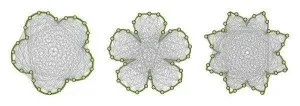Feral colonies provide clues for enhancing honey bee tolerance to pathogens
2021-01-21
(Press-News.org) Understanding the genetic and environmental factors that enable some feral honey bee colonies to tolerate pathogens and survive the winter in the absence of beekeeping management may help lead to breeding stocks that would enhance survival of managed colonies, according to a study led by researchers in Penn State's College of Agricultural Sciences.
Feralization occurs when previously domesticated organisms escape to the wild and establish populations in the absence of human influence, explained lead researcher Chauncy Hinshaw, doctoral candidate in plant pathology and environmental microbiology.
"In the case of honey bees, colonies that escape domestication and establish in the wild provide an opportunity to study how environmental and genetic factors affect the fitness of feral organisms compared to their domesticated counterparts," Hinshaw said. "Some have suggested that the artificial selection associated with domestication of honey bees has decreased their fitness and has made managed colonies vulnerable to pests and pathogens."
Feral honey bees frequently interact with both managed and wild bee species, playing a critical role in the dynamics of pathogens that are shared among these closely related groups, noted study co-author Margarita López-Uribe, assistant professor of entomology and Lorenzo L. Langstroth Early Career Professor.
"Both domesticated and feral honey bees face serious challenges from a large number of pests and pathogens, but feral honey bees must deal with diseases by themselves since they don't have beekeepers helping them control pest problems in the colony," she said. "This makes honey bees an ideal model to investigate the hypothesis that host-pathogen dynamics during feralization can result in higher disease pressure and pathogen tolerance in feral organisms."
The research team set out to answer three questions: Are feral colonies reservoirs of pathogens, with high pathogen levels compared to managed colonies? Do increased pathogen levels lead to higher expression of immune genes in feral colonies than in managed colonies? Is immune gene expression correlated with survival of honey bee colonies?
To address these questions, the researchers partnered with beekeepers to locate 25 feral honey bee colonies across Pennsylvania and paired each of those colonies with a managed colony within a seven-mile radius to control for climate and landscape variation. The team surveyed these colonies over a two-year period to measure winter survival, levels of three pathogens -- deformed wing virus, black queen cell virus and Nosema ceranae -- and expression of six genes that regulate immunity.
Deformed wing virus, or DWV, is considered the most serious honey bee viral pathogen because of its prevalence worldwide and its role in winter losses of colonies. DWV and other viruses often are spread by parasitic Varroa mites, requiring beekeepers to implement management strategies to minimize mite infestations among their bees.
The team's findings, recently published in Frontiers in Ecology and Evolution, indicated that feral colonies had higher levels of DWV, but it was variable over time compared to managed colonies. In addition, higher pathogen levels were associated with increased immune gene expression, with feral colonies showing higher expression in five of the six examined immune genes for at least one sampling period.
"We also found that differential expression of the immune genes hymenoptaecin and vago increased the odds of overwintering survival in both managed and feral colonies," Hinshaw said. "As a result, these two genes could be considered biomarkers of honey bee health that can be used to predict the ability of a colony to survive the winter."
López-Uribe said the results provide evidence for the role of feralization in altering pathogen landscapes and host immune responses.
"Our study was the first to show the association of host-pathogen dynamics with survival of feral colonies," she said. "Further research to identify the genetic mechanisms of virus tolerance and biomarkers of bee health can help breeding efforts to enhance these traits in selected honey bee stocks, with the goal of decreasing colony losses for the beekeeping industry."
INFORMATION:
Other researchers on the project were Kathleen Evans, doctoral candidate in entomology at the University of Maryland, and Cristina Rosa, associate professor of plant virology, Penn State.
The Penn State College of Agricultural Sciences' Strategic Networks and Initiatives Program partially funded this work through the Graduate Training Program in Integrative Pollinator Ecology. The U.S. Department of Agriculture's National Institute of Food and Agriculture also supported the research.
[Attachments] See images for this press release:
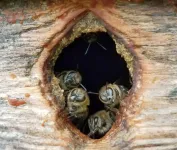
ELSE PRESS RELEASES FROM THIS DATE:
2021-01-21
Muscle structure and body size predict the athletic performance of Olympic athletes, such as sprinters. The same, it appears, is true of wild seabirds that can commute hundreds of kilometres a day to find food, according to a recent paper by scientists from McGill and Colgate universities published in the Journal of Experimental Biology.
The researchers studied a colony of small gulls, known as black-legged kittiwakes, that breed and nest in an abandoned radar tower on Middleton Island, Alaska. They attached GPS-accelerometers--Fitbit for birds -- ...
2021-01-21
Warming ocean waters could reduce the ability of fish, especially large ones, to extract the oxygen they need from their environment. Animals require oxygen to generate energy for movement, growth and reproduction. In a recent paper in the Proceedings of the National Academy of Science, an international team of researchers from McGill, Montana and Radboud universities describe their newly developed model to determine how water temperature, oxygen availability, body size and activity affect metabolic demand for oxygen in fish.
The model is based on physicochemical principles that look at oxygen consumption and diffusion at the gill surface in relation to water temperature and body size. Predictions were compared against actual measurements from over 200 fish species where oxygen ...
2021-01-21
A McGill-led research team has identified a new species of praying mantis thanks to imprints of its fossilized wings. It lived in Labrador, in the Canadian Subarctic around 100 million years ago, during the time of the dinosaurs, in the Late Cretaceous period. The researchers believe that the fossils of the new genus and species, Labradormantis guilbaulti, helps to establish evolutionary relationships between previously known species and advances the scientific understanding of the evolution of the most 'primitive' modern praying mantises. The unusual find, described in a recently published study in Systematic ...
2021-01-21
A recent McGill study published in Environmental Science and Technology finds that annual methane emissions from abandoned oil and gas (AOG) wells in Canada and the US have been greatly underestimated - by as much as 150% in Canada, and by 20% in the US. Indeed, the research suggests that methane gas emissions from AOG wells are currently the 10th and 11th largest sources of anthropogenic methane emission in the US and Canada, respectively. Since methane gas is a more important contributor to global warming than carbon dioxide, especially over the short term, the researchers believe that it is essential to gain a clearer understanding of methane ...
2021-01-21
WINSTON-SALEM, N.C. - Jan. 20, 2021 - Breast cancer is the second most common cancer among women in the United States, and cigarette smoking is associated with a higher incidence of breast cancer spread, or metastasis, lowering the survival rate by 33% at diagnosis.
While cigarette smoking's link to cancer is well-known, the role of nicotine, a non-carcinogenic chemical found in tobacco, in breast-to-lung metastasis is an area where more research is needed.
Now, scientists at Wake Forest School of Medicine have found that nicotine promotes the spread of breast cancer cells into the lungs.
The study ...
2021-01-21
No evidence so far indicates that food or drinks can transmit the virus that causes COVID-19, but new research at Washington University School of Medicine in St. Louis suggests that people with problems in the upper gastrointestinal (GI) tract may be vulnerable to infection after swallowing the virus.
Studying tissue from patients with a common disorder called Barrett's esophagus, the researchers found that although cells in a healthy esophagus cannot bind to the SARS-CoV-2 virus, esophageal cells from patients with Barrett's have receptors for the virus, and those cells can bind to and become infected by the virus that causes COVID-19.
The study is published online Jan. 20 in the journal Gastroenterology.
"There ...
2021-01-21
20 January 2021/Kiel. Numerous natural products are awaiting discovery in all kinds of natural habitats. Especially microorganisms such as bacteria or fungi are able to produce diverse natural products with high biomedical application potential in particular as antibiotics and anticancer agents. This includes the so-called red yeast of the species Rhodotorula mucilaginosa, isolated from a deep-sea sediment sample from the Mid-Atlantic Ridge and analyzed for its genome and chemical constituents by researchers from GEOMAR Centre for Marine Biotechnology (GEOMAR-Biotech) ...
2021-01-21
In a paper published in NANO, researchers from Hubei, China discuss the top-down and bottom-up strategies for the synthesis of Graphene quantum dots (GQDs). The respective advantages and disadvantages of these methods are summarized. With regard to some important or novel ones, the mechanisms are proposed for reference. In addition, the application of GQDs in biosensors is highlighted in detail.
At present, various top-down methods, such as oxidative cutting, hydrothermal or solvothermal reactions, electrochemical oxidation, ultrasonic-assisted or microwave-assisted process, chemical vapor deposition (CVD) have been reported to produce GQDs. Meanwhile, the bottom-up methods have been ...
2021-01-21
Changes in climate that occur over short periods of time influence biodiversity. For a realistic assessment of these effects, it is necessary to also consider previous temperature trends going far back into Earth's history. Researchers from the University of Bayreuth and the University of Erlangen-Nuremberg show this in a paper for Nature Ecology and Evolution. According to the paper, future climate-related species extinction could be less severe than predictions based only on the current trend of global warming. However, the researchers do not give the all-clear. At present, the effects of climate change are being exacerbated ...
2021-01-21
In nature, many things have evolved that differ in size, color and, above all, in shape. While the color or size of an object can be easily described, the description of a shape is more complicated. In a study now published in Nature Communications, Jacqueline Nowak of the Max Planck Institute of Molecular Plant Physiology and her colleagues have outlined a new and improved way to describe shapes based on a network representation that can also be used to reassemble and compare shapes.
Jacqueline Nowak designed a novel approach that relies on a network-based shape representation, named visibility graph, along with a tool for analyzing shapes, ...
LAST 30 PRESS RELEASES:
[Press-News.org] Feral colonies provide clues for enhancing honey bee tolerance to pathogens

